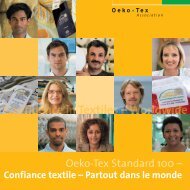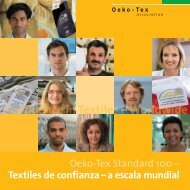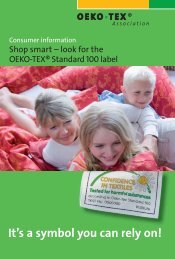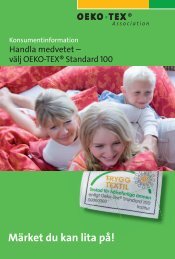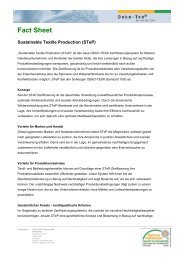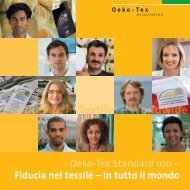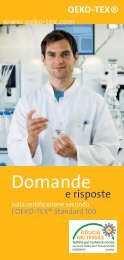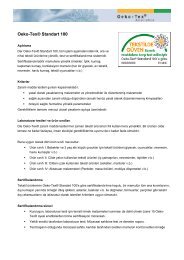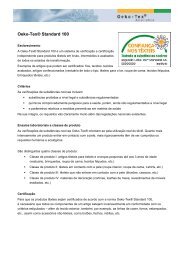OETS 100 SalesPro HOME TEXTILES EN - Oeko-Tex
OETS 100 SalesPro HOME TEXTILES EN - Oeko-Tex
OETS 100 SalesPro HOME TEXTILES EN - Oeko-Tex
Create successful ePaper yourself
Turn your PDF publications into a flip-book with our unique Google optimized e-Paper software.
OEKO-TEX® SALESPRO GAMES 2012<br />
FOR SALES PROFESSIONALS<br />
Home textiles category<br />
Testing textiles for harmful<br />
substances<br />
Know more – give better advice<br />
Sign up by 15.05.2012 at www.oeko-tex.com/salespro<br />
Training material<br />
Training provided by the<br />
Foundation OEKO-TEX® and<br />
the Federation of German<br />
<strong>Tex</strong>tile Retailers (BTE)<br />
BTE<br />
Bundesverband<br />
<strong>Tex</strong>tileinzelhandel
TRAINING MATERIAL<br />
The OEKO-TEX®<br />
Standard <strong>100</strong> – what is it?<br />
The product label “Confidence in <strong>Tex</strong>tiles<br />
– textiles tested for harmful substances<br />
according to OEKO-TEX® Standard <strong>100</strong>”<br />
is an independent certification system<br />
for textile products of all kinds (untreated<br />
and dyed/finished yarns and fabrics,<br />
manufactured articles, accessories)<br />
which have been proved to be free of any<br />
substances which might be harmful to<br />
people‘s health.<br />
In order for an article to be certified and<br />
endorsed with the OEKO-TEX® label, every<br />
part of it without exception must comply<br />
with the required test criteria - so not only<br />
the outer material and the sewing yarns<br />
but also accessories like ribbons, cords and<br />
filling foam, as well as any coatings, prints<br />
or other patches.<br />
Labels<br />
The laboratory testing and certification of<br />
the textiles is carried out by one of the 15<br />
OEKO-TEX® member institutes in Europe<br />
and Japan. In Germany and France, the<br />
certificates are issued by the OEKO-TEX®<br />
Certification Centre.<br />
The testing for harmful substances is<br />
based on an extensive list of criteria<br />
which is updated annually and sets out<br />
requirements for safe textile products<br />
that apply universally worldwide. The test<br />
criteria cover:<br />
• legally banned and regulated substances<br />
(e.g. certain carcinogenic dyes, phthalates<br />
and heavy metals such as nickel)<br />
• chemicals that are harmful to the health<br />
but for which there are not yet any<br />
statutory regulations<br />
(e.g. certain allergenic dispersion dyes,<br />
pesticides, tin organic compounds)<br />
• parameters for health protection<br />
(e.g. a skin-friendly pH value,<br />
good colour-fastness)<br />
Sewing thread<br />
Zips<br />
Press studs<br />
Fabrics<br />
Jeans<br />
Chart: In order for an article to be<br />
certified and endorsed with the<br />
OEKO-TEX® label, every part of it<br />
without exception must comply<br />
with the required test criteria.
OEKO-TEX® SALESPRO GAMES 2012<br />
FOR SALES PROFESSIONALS<br />
What kind of products carry the OEKO-TEX® label<br />
and where can I find them?<br />
The main focus for product certification<br />
under the OEKO-TEX® Standard <strong>100</strong> is on<br />
clothing and domestic textiles, but it also<br />
apples to technical and medical textiles.<br />
When it comes to domestic textiles, the<br />
“Confidence in <strong>Tex</strong>tiles” label is most<br />
widely used for sensitive products such<br />
as bed-linen, bedding and towelling<br />
products of all kinds. However, numerous<br />
other furnishing materials such as<br />
curtains, blinds, net curtains, textile floor<br />
and wall coverings and upholstery fabrics<br />
can be endorsed with the OEKO-TEX®<br />
label.<br />
Since product labelling is voluntary, not<br />
all certified articles also carry the OEKO-<br />
TEX® label. In cases of doubt, it is therefore<br />
worth asking the manufacturer about<br />
specific items - and this is where you can<br />
score as a specialist salesperson!<br />
OEKO-TEX® certified textiles are available<br />
in all sections of the retail trade:<br />
• in specialist household textile retailers<br />
• in specialist departments of department<br />
stores<br />
• from mail-order retailers (catalogues and<br />
online)<br />
• from discount stores in the non-food sector<br />
• on online portals and exchange markets<br />
Why OEKO-TEX®? – 4 good reasons<br />
<strong>Tex</strong>tiles certified under the OEKO-<br />
1<br />
TEX® Standard <strong>100</strong> offer consumers<br />
real additional benefits!<br />
They have been proved not to be harmful<br />
to our health and at the same time they<br />
also have other product properties which<br />
consumers are looking for today, depending<br />
on the intended purpose of the textiles:<br />
– soft and easy-care materials, bright<br />
colours and patterns, good colourfastness,<br />
a long service life, reasonable<br />
price etc.<br />
Much of what we wish for and<br />
2<br />
expect to find in modern textile<br />
products can only be achieved with the<br />
use of certain chemicals!<br />
That is why it is all the more important<br />
that no undesirable substances are used<br />
during the textile production, which could<br />
remain as a residue in the end product and<br />
cause health problems for the wearer.<br />
The safety of textiles is a quality<br />
3<br />
feature which cannot be judged by<br />
the naked eye - neither by you as a trained<br />
sales representative nor by the buyer<br />
themselves!<br />
Whether or not an article contains<br />
undesirable harmful substances can<br />
only be established beyond doubt by<br />
specific tests in the laboratory. There is<br />
different legislation on possible harmful<br />
substances for different processing stages<br />
and countries. That is why the OEKO-TEX®<br />
list of criteria is so important, because it is<br />
applied consistently worldwide.<br />
OEKO-TEX® product classes<br />
The voluntary OEKO-TEX® label<br />
4<br />
contributes to greater product<br />
safety, because it covers numerous<br />
substances and test parameters which are<br />
not yet explicitly regulated by law.<br />
That is why the label is a valuable<br />
supplement to the legal regulations and<br />
product controls imposed by national<br />
investigating offices. OEKO-TEX® criteria<br />
still often provide the precedent for new<br />
legislation and greater consumer protection.<br />
Under the OEKO-TEX® Standard <strong>100</strong>, a distinction is made between four product classes, depending on the intensity of the contact<br />
with the skin:<br />
Product Class I<br />
Articles for babies and<br />
toddlers under the age of 3<br />
such as rompers, bibs, bedlinen,<br />
pillows, blankets, towels,<br />
bath-robes, face-cloths,<br />
changing mats, sleeping bags,<br />
stuffed toys and many more<br />
Product Class II<br />
Articles used close to the<br />
skin<br />
such as clothing worn next to<br />
the skin, or, in the domestic<br />
textiles sector, pyjamas,<br />
pillows, blankets, bed-linen,<br />
towels, mattresses etc.<br />
Product Class III<br />
Articles not in contact with<br />
the skin<br />
e.g. jackets, coats, outdoor<br />
items etc.<br />
Product Class IV<br />
Furnishing fabrics for<br />
decorative purposes<br />
e.g. table linen, blinds,<br />
curtains, net curtains,<br />
bedspreads, floor coverings,<br />
upholstery fabrics, loose<br />
covers, throws, wall coverings<br />
etc.
BTE & FOUNDATION OEKO-TEX®<br />
Home sweet home –<br />
7 facts for all-round safety<br />
The aim of product certification under<br />
the OEKO-TEX® Standard <strong>100</strong> is to endorse<br />
products that have been proved not to be<br />
harmful to people’s health.<br />
For consumers, the “Confidence in<br />
<strong>Tex</strong>tiles” label provides a high degree of<br />
security in several different regards:<br />
The test criteria and methods<br />
1<br />
underpinning the OEKO-TEX® label<br />
are based on the specific intended use<br />
Products in direct and intensive contact<br />
with the skin have to meet stricter<br />
requirements than articles that are not<br />
worn next to the skin. Because babies have<br />
particularly sensitive skin, there are even<br />
stricter specfications for their products<br />
than for textiles like bed-linen that are in<br />
contact with the skin.<br />
The test criteria are updated every<br />
2<br />
year and are mandatory<br />
worldwide.<br />
So it makes no difference where<br />
OEKO-TEX® certified products were<br />
manufactured or sold.<br />
A certificate is only awarded if all<br />
3<br />
the components of an end product<br />
comply with the OEKO-TEX® requirements.<br />
The OEKO-TEX® test methods take<br />
4<br />
account of all the possible ways in<br />
which harmful substances may be<br />
absorbed into the human body:<br />
> by inhaling (emissions testing)<br />
> by swallowing (simulation tests using<br />
synthetic saliva solution)<br />
> through the skin (simulation tests using<br />
synthetic sweat solution)<br />
The laboratory tests are carried out<br />
5<br />
only by specialised, independent<br />
and accredited textile testing institutes.<br />
OEKO-TEX® also carries out random<br />
6<br />
checks after the certificate has<br />
been issued, to ensure continued<br />
compliance with the required test criteria.<br />
Products bearing the OEKO-TEX® label<br />
are purchased from retailers and tested<br />
in the laboratory. Product inspections are<br />
carried out every year on at least 20% of<br />
all certificates issued.<br />
Consumers can check the validity<br />
7<br />
of an OEKO-TEX® label themselves<br />
at any time on the Internet, using the test<br />
number on the label.<br />
(www.oeko-tex.com/validity)<br />
Further training for the Home <strong>Tex</strong>tiles<br />
category / <strong>SalesPro</strong> Games 2012<br />
More training material, entitled<br />
„A good sign - the „Confidence in<br />
<strong>Tex</strong>tiles“ label“, can be downloaded<br />
from www.oeko-tex.com/salespro.<br />
You can also order it in pocket format<br />
as an information brochure for your<br />
customers from OEKO-TEX®.<br />
Matratzen, Bettwäsche, Frottierware,<br />
Bettwaren, Kissen, Decken, Gardinen,<br />
Kundeninformation Vorhänge, Dekostoffe, Tischwäsche,<br />
Heimtextilien Möbelstoffe, zum Wohlfühlen textile Wand- und<br />
Bodenbeläge, Vorleger, Babybettwaren,<br />
Babybettwäsche u.v.m.<br />
Ein gutes Zeichen:<br />
Das Label „<strong>Tex</strong>tiles Vertrauen“<br />
A good sign –<br />
The „Confidence in <strong>Tex</strong>tiles“<br />
label<br />
Consumer information<br />
Shop smart – look for the<br />
OEKO-TEX® Standard <strong>100</strong> label<br />
It’s a symbol you can rely on!<br />
Shop smart–<br />
with the OEKO-TEX®<br />
Standard <strong>100</strong> label
Why is testing for harmful substances<br />
particularly important for home textiles?<br />
Features of high-quality<br />
home textiles<br />
Towels<br />
soft but absorbent materials,<br />
fashionable colours and designs<br />
good colour-fastness, easy-care<br />
materials<br />
available over many years /<br />
more can be bought later<br />
Table linen<br />
hard wearing, long-lasting<br />
materials<br />
resistant to light<br />
Domestic textiles used in contact with<br />
the skin<br />
Bed-linen is in direct contact with large<br />
areas of our skin for several hours at a<br />
time. Furthermore, pillow cases and duvet<br />
covers, as well as sheets, often come in<br />
dark colours or with bright prints. Another<br />
important factor is that people give off up<br />
to quarter of a litre of sweat every night<br />
and that skin which is moist with sweat<br />
generally makes undesirable substances<br />
more likely to be released from the textile<br />
material.<br />
Naturally, the OEKO-TEX® Standard <strong>100</strong> has<br />
been protecting people from carcinogenic<br />
dyes, pesticides and problematic<br />
preservatives such as pentachlorophenol<br />
(PCP) for 20 years now. In addition, in the<br />
case of bed-linen, OEKO-TEX® also requires<br />
good colour-fastness in the certified<br />
products, as well as the usual criteria. The<br />
resistance of the test samples to rubbing,<br />
sweat and water is assessed to ensure that<br />
even where there is a lot of movement, and<br />
sweaty skin, no undesirable substances<br />
are released from the textile material<br />
which could be absorbed by the body.<br />
Another focus for the OEKO-TEX®<br />
laboratory testing is to exclude allergenic<br />
substances such as nickel (e.g. in buttons<br />
or zip fasteners), formaldehyde (used to<br />
help the textile keep its shape and avoid<br />
creasing) and certain dispersion dyes<br />
(used to dye synthetic bed-linen fabrics<br />
containing polyester and polyamide).<br />
Furnishing fabrics for decorative purposes<br />
In the case of larger furnishing fabrics such<br />
as table-cloths, curtains, blinds, upholstery<br />
covers or floor coverings, undesirable<br />
components can escape into the air and<br />
be inhaled by people as they breathe.<br />
Another factor is that this kind of item is<br />
usually not washed before use and rarely<br />
afterwards.<br />
OEKO-TEX® laboratory testing therefore<br />
ensures that furnishing materials do not<br />
pose a health risk right from the start.<br />
In addition to the usual requirements,<br />
items with a large surface area or volume<br />
(e.g. including mattresses) also have to<br />
go through special emissions testing, to<br />
ensure that they do not release volatile<br />
substances into the atmosphere.<br />
easy-care<br />
Bed-linen<br />
bright colours, fashionable designs<br />
good colour-fastness<br />
long service life<br />
easy-care<br />
keep their shape (don‘t shrink)<br />
Blinds/curtains<br />
brilliant colours<br />
resistant to light<br />
Decorative materials<br />
fashionable colours and designs<br />
available over many years /<br />
more can be bought later<br />
wide range of materials<br />
Bedding<br />
very comfortable to sleep in<br />
(thermal insulation, breathability)<br />
long service life<br />
hygienic easy-care materials
OEKO-TEX® SALESPRO GAMES 2012<br />
FOR SALES PROFESSIONALS<br />
3 tips for selling<br />
Be proactive in pointing out to your<br />
1<br />
customers the additional benefits<br />
of textiles that have been tested for<br />
harmful substances under the OEKO-TEX®<br />
Standard <strong>100</strong>.<br />
Many customers do value the safety of the<br />
articles they are buying but may initially<br />
have other priorities (bright colours and<br />
patterns, long lasting, easy to wash, soft<br />
and supple materials etc.) and may not<br />
even know that there are products that<br />
have been tested for harmful substances.<br />
At www.oeko-tex.com/salespro<br />
2<br />
you can find a list of OEKO-TEX®<br />
certified manufacturers and brands in the<br />
domestic textiles sector.<br />
Look to see whether you have products<br />
from these manufacturers/brands in your<br />
own range and point out to interested<br />
customers that there is a list of OEKO-TEX®<br />
certified branded articles that anyone<br />
can look at on the OEKO-TEX® website at<br />
www.oeko-tex.com/brands<br />
For more and more consumers,<br />
3<br />
environmentally friendly and<br />
socially responsible production of textiles<br />
plays an important role in their purchasing<br />
decisions.<br />
(I)<br />
Demonstrate your specialist expertise<br />
by pointing out to your customer that<br />
there is a special certification process<br />
for assessing environmentally friendly<br />
and socially responsible production<br />
processes at textile factories – the<br />
OEKO- TEX® Standard <strong>100</strong>0.<br />
(II) Try to explain to your customer as<br />
clearly as possible the main idea<br />
behind the OEKO-TEX® Standard <strong>100</strong> –<br />
what it can actually achieve:<br />
> the aim of the certification is to<br />
exclude possibly harmful substances<br />
from textile production and so to<br />
offer consumers safe products.<br />
> In that context, the “Confidence in<br />
<strong>Tex</strong>tiles” label is not only suitable<br />
for “niche products” made of organic<br />
raw materials and produced in<br />
environmentally friendly conditions<br />
but covers a wide range of the<br />
products that are available today<br />
and produced using conventional<br />
methods.<br />
(III) For example, you could also explain<br />
to your customer that the use of<br />
raw materials from certified organic<br />
farms (“organic cotton”) by no means<br />
guarantees that textile products<br />
are safe – as a result of subsequent<br />
production stages such as dyeing and<br />
finishing, harmful chemicals can end<br />
up in these textiles too.<br />
Use your knowledge to score points and win!<br />
In the year of the summer Olympics, measure your specialist knowledge<br />
against colleagues from all over Europe in the “OEKO-TEX® <strong>SalesPro</strong><br />
Games 2012”. The best sales staff from various product categories will<br />
be able to enjoy a trip to London to the Olympic Games or one of several<br />
valuable material prizes.<br />
www.oeko-tex.com/salespro<br />
BTE<br />
Bundesverband<br />
<strong>Tex</strong>tileinzelhandel<br />
More information and contact: International OEKO-TEX® Association | Secretariat | Gotthardstrasse 61 | Postfach 2156 | CH-8027 Zürich | info@oeko-tex.com |<br />
www.oeko-tex.com | Foundation OEKO-TEX® GmbH | Kaiserstraße 39 | 60329 Frankfurt | Germany | info@certification-oekotex.com




